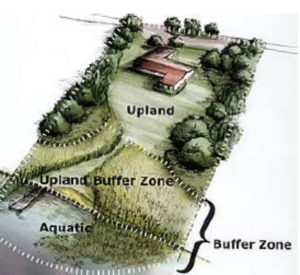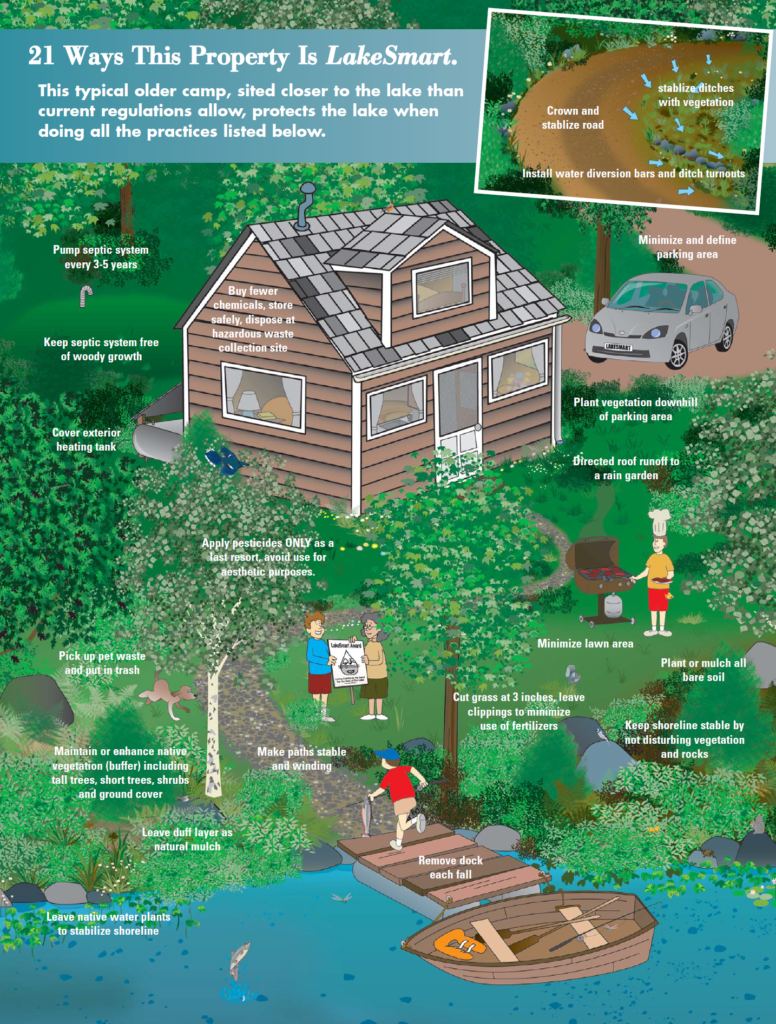Shoreline conditions can have a significant lake impact
Does your shoreline support good lake conditions? We can learn a lot from the natural areas around our lakes. Lakes reflect what is done on the land around it, since the water runs off the land and into the lake. The faster the water runs, the more energy it has for carrying particles and pollution, and the greater the chance for erosion.
Our goal is to manage water runoff and slow it down before it reaches the lake. Of course roofs, sidewalks, and driveways not only allow water to run off quickly, they often concentrate flow and give water more energy for carrying pollution. Steeper and more compacted soils allow the water to run off faster than flatter areas, or areas with more plants.
A good shoreline buffer has vegetation layers.
A buffer is a strip of mixed vegetation along the lake. Trees, shrubs, ground covers, and duff shield the lake from runoff and erosion. 
Their shade also helps keep the water cooler, and shade discourages the growth of plants and algae in the lake. If you are lucky enough to have healthy trees by the lake, please protect them.
Grass acts as the opposite of trees. Water will run off a lawn quite quickly. Even worse, lawns often have pet waste, herbicides, and fertilizers that can be carried in water and pollute the lakes.
If you have lawn by the lake, consider replacing some of it with groundcovers, or even just not mowing it and see what nature provides.
Shrubs. Plant some native shrubs and bushes which will help slow water flow or provide shade.
Mulch or leaf litter forms duff, an absorbent blanket for soil. This helps slow and retain rain water.
Emergent plants in the water along part of your lake shore will also help protect the shore from erosion caused by waves and boat wakes.
Be lake smart.
The goal is not to let water from your lawn reach the lake without pausing for some filtration. And any buffer is better than none!
| Land Use and Runoff Percent |
|
| forest | 5% |
| park | 15% |
| lawn | 25% |
| walks & streets | 80% |
| roof | 90% |
As we see warmer temperatures and more storms, the conditions of our shorelines are even more important to the conditions of our lakes. See this article from the North American Lake Management Society for the importance of shoreline resilience to lake health.
Reduce hard surfaces to protect water quality
Hard surfaces like roads, roofs, patios,and driveways don’t let water infiltrate into the ground. The more impervious surface you have, the more runoff – and the bigger the impact on water quality. Research shows the impact of impervious surface on water quality.
| Impact of impervious surface amounts on waterways | |
| % impervious | effect |
| up to 10% | protected |
| 10% – 25% | impacted |
| above 25% | degraded |
The lesson – try to keep impervious surfaces less than 10% of the area surrounding our lakes to protect our water quality.
Use native plants!
Native plants are adapted to our climate and therefore need less maintenance. Native plants support native wildlife like pollinators and generally resist pests.
One-third of our area’s native plants are endangered. By choosing native plants you can help these local species survive.
More information: Westchester County’s native plant brochure and Guide to Aquatic Buffers
